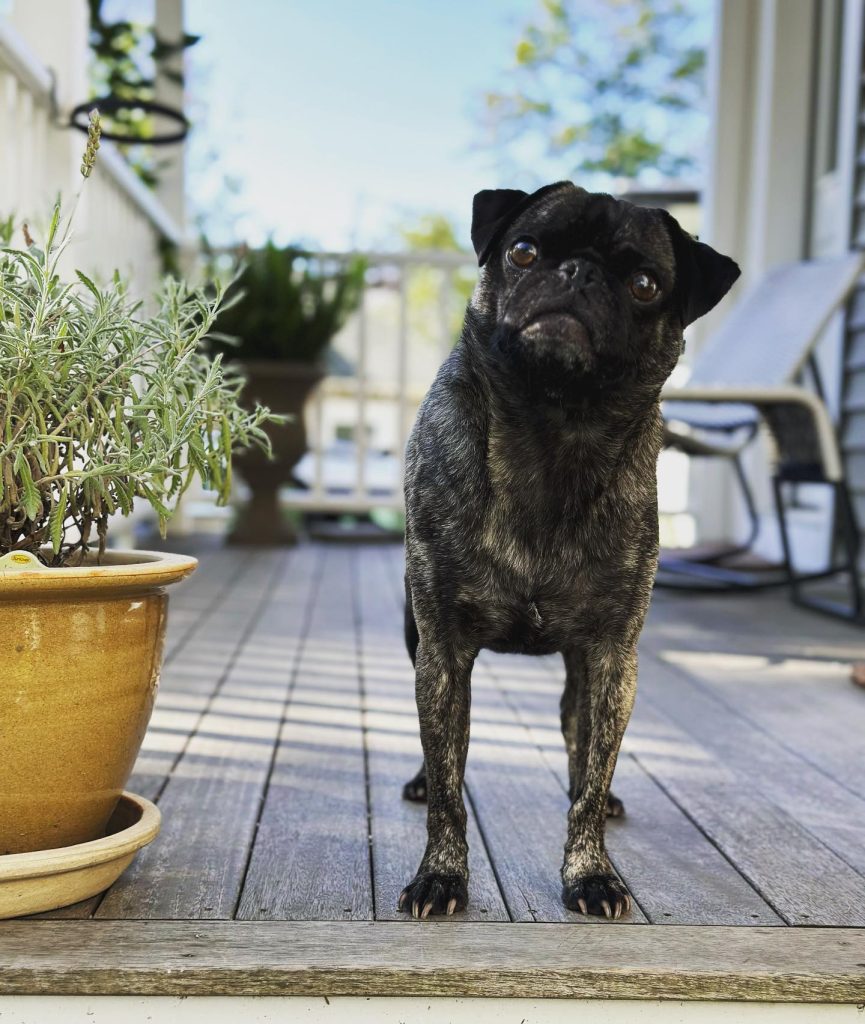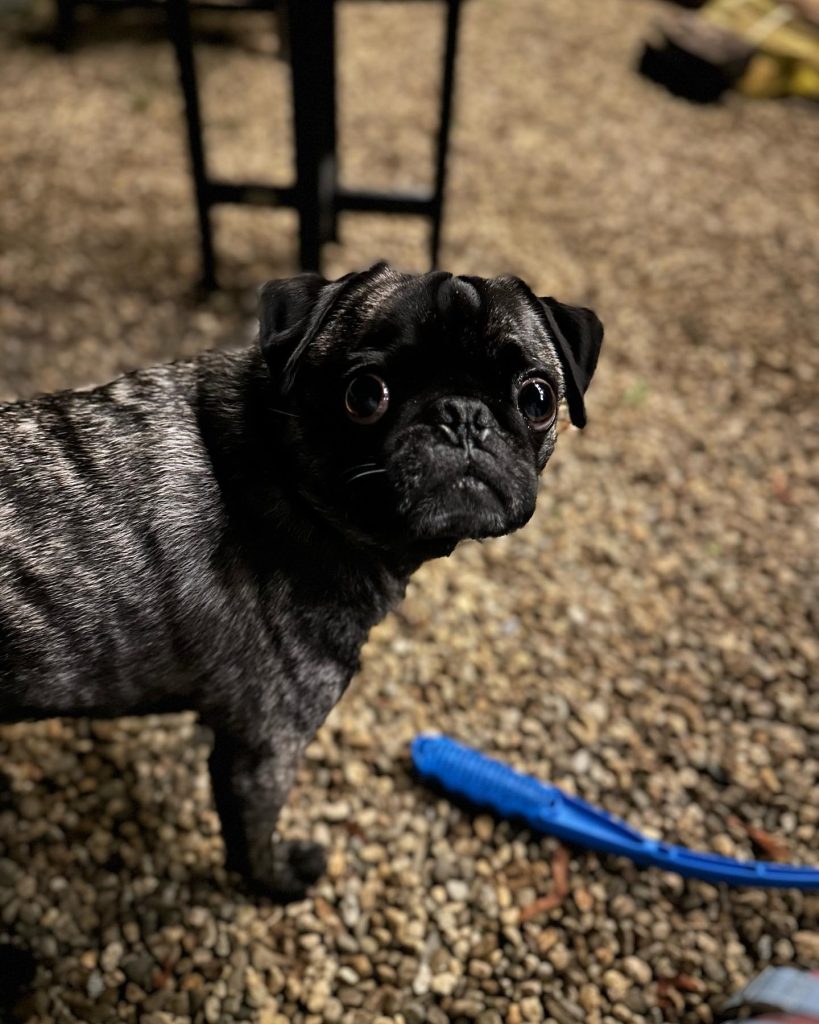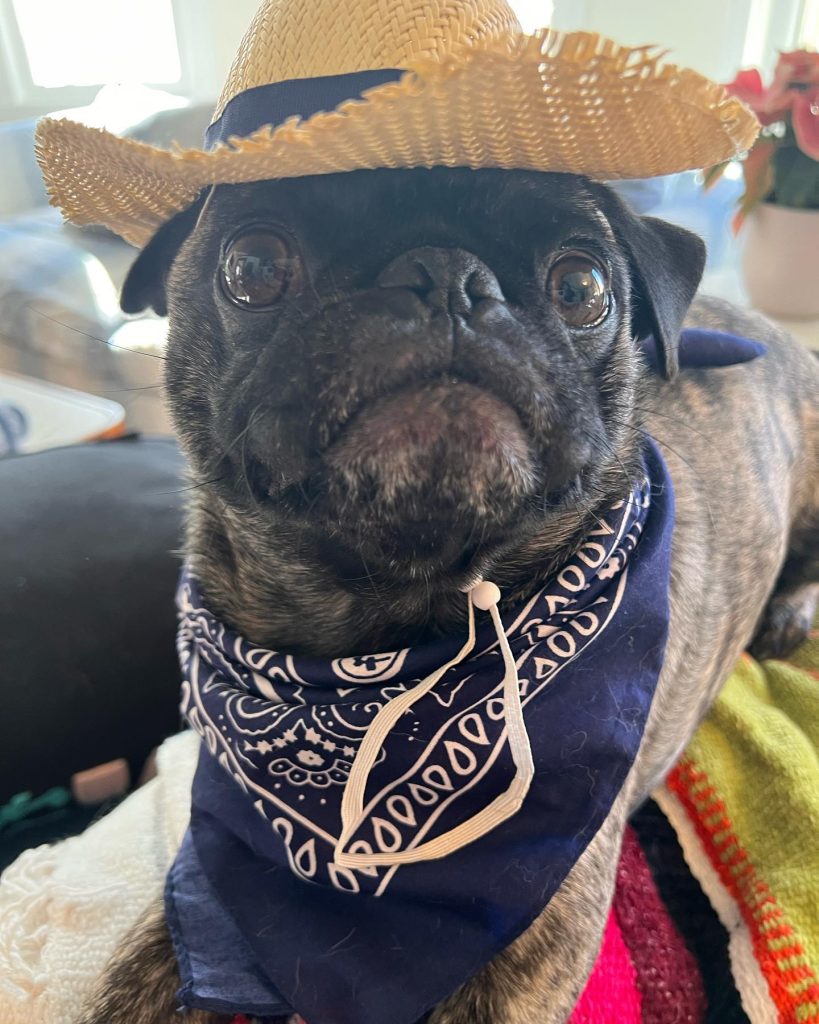
Pugs are a distinctive and beloved small dog breed known for their expressive faces and charming personalities. These small, sturdy companions have captured the hearts of dog lovers worldwide with their playful spirit and affectionate nature. Originating from China, pugs have a rich history as royal pets and have maintained their status as a popular choice for families and individuals seeking a loyal companion dog. The pug is a popular breed among those who value companionship and affection in a compact package.
Breed Overview and History of The Pug
Pugs are characterized by compact, muscular bodies and distinctive facial features, including oversized, round eyes and a short, wrinkled muzzle. They typically weigh between 14 and 18 pounds, making them manageable for most living situations. Their coat, which comes in various colors including fawn, black, and sometimes silver or brindle, is short but requires regular grooming to manage shedding. Owning a pug named is often described as having a loyal and affectionate companion, bringing joy and laughter to their owner’s life.
One of the most endearing qualities of pugs is their friendly and loving demeanor. They thrive on human companionship and are known to be particularly good with children and other pets. This breed is also known for its adaptability, able to live happily in apartments and larger homes as long as they are close to their human family. Pugs were bred to be companion animals, and their affectionate nature reflects their long history of close relationships with humans.
Unveiling the Pug Health, Personality and Temperament
The personality of a modern pug is a tapestry of charm, mischief, and affection that endears them to everyone they meet. Renowned for their sociable and cheerful disposition, pugs possess a unique blend of dignity and comedy, making them not just pets but true members of the family. Their expressive faces often mirror their mood, offering a window into a rich emotional life that ranges from joyous exuberance to contemplative thoughtfulness. Pugs shed regularly, so regular grooming is necessary to keep their coat healthy and reduce shedding around the home.
Understanding Pug Temperament and Behavior
Delving into the temperament and behavior of pugs reveals a breed that is both eager to please and stubbornly independent. This duality makes for a fascinating companion who can switch from being a lapdog one moment to exploring their surroundings with tenacity the next. Pugs are known for their love of attention, often following their owners around the house and seeking affection with their big, soulful eyes.
Despite their small size, pugs carry a big personality, marked by a playful and sometimes mischievous streak. They enjoy engaging in playful activities but are also content to curl up beside their favorite human for a quiet evening. Their adaptability to different environments and situations is coupled with a sensitivity that requires a gentle and understanding approach to training. Understanding the pug’s temperament is key to unlocking the complete joy and companionship these delightful dogs offer.
The Physical Makeup of a Pug
Pugs are a breed that commands attention not just with their personality but also their distinctive physical appearance. These dogs are small yet sturdy, with a square, compact frame that is surprisingly muscular for their size. Their physical attributes, coupled with their expressive faces, make black pugs instantly recognizable and perpetually endearing.
Size and Physical Characteristics
- Size: Pugs typically weigh between 14 and 18 pounds and stand about 10 to 13 inches tall at the shoulder, embodying a compact and stocky build.
- Head: They have a large, round head with a short, flat snout and deep wrinkles, especially pronounced around their big, dark eyes.
- Ears: Their ears can be either “rose” or “button” shaped, sitting high on their head and adding to their alert expression.
- Tail: A pug’s tail is one of its most distinctive features. It is tightly curled over its hip, with some pugs boasting a double curl.
Coat Types and Grooming Needs
Pugs have a fine, smooth coat that comes in various colors, most commonly fawn or black. Their coat, while short, requires regular grooming due to their shedding:
- Brushing: Weekly brushing is recommended to remove loose hair and maintain coat health.
- Bathing: Occasional baths will keep their coat clean without drying out their skin.
- Wrinkle Care: Special attention should be given to cleaning their facial wrinkles to prevent irritation or infection.
Understanding the physical makeup of a pug is crucial for prospective owners, as their unique characteristics come with specific care and grooming needs.
A Deep Dive into Pug History

The Historical Journey of the Pug Breed
The pug’s lineage traces back to ancient China, where they were esteemed by emperors and nobility, often kept in luxury and guarded by soldiers. These dogs were valued for their distinctive looks and affable nature, serving as companions and symbols of status and wealth. The breed’s journey from East to West is a tale of admiration and affection, as traders and explorers brought them to European shores, quickly becoming favorites among royalty and aristocrats. The black pugs fashionable appearance only added to their allure, making them sought-after pets among the elite.
Health and Wellness of Pugs
Pugs are delightful companions with a spirited disposition, but their unique physical characteristics necessitate mindful care to ensure their health and well-being. Prospective and current pug owners must be vigilant about certain breed-specific health concerns and nutritional needs to foster a healthy, happy life.
Common Health Concerns in Pugs
Pugs, with their distinct appearance and compact size, are prone to several health issues that require attention and preventative care:
- Brachycephalic Syndrome: Due to their short snouts, pugs often experience breathing difficulties, which can be exacerbated by obesity or strenuous exercise, especially in hot weather.
- Skin Infections: Their deep facial wrinkles need regular cleaning to prevent bacterial infections.
- Eye Conditions: Large, protruding eyes make pugs susceptible to injuries and disorders like corneal ulcers or dry eye.
- Joint Problems: Their stout build puts them at risk for hip dysplasia and patellar luxation.
- Obesity: Pugs love to eat, which can easily lead to weight gain, exacerbating other health issues.
Nutritional Needs and Diet
A balanced diet tailored to their specific needs is crucial for maintaining a pug’s health:
- Portion Control: Given their propensity for obesity, careful monitoring of food intake is essential. Consult a veterinarian to determine the ideal daily calorie intake based on age, weight, and activity level.
- Balanced Diet: High-quality dog food that balances protein, carbohydrates, fats, and fibers is recommended. Some owners opt for breed-specific formulas designed for small breeds with unique needs.
- Hydration: Adequate water intake is crucial to support kidney function and overall health.
- Treats: While tempting, treats should be given sparingly to avoid excess weight gain.
Caring for a pug’s health involves a combination of regular veterinary check-ups, proactive monitoring for signs of common health issues, and a nutritious diet tailored to their specific needs. This comprehensive approach ensures that pugs can lead a full, vibrant life alongside their human companions. Understanding the specific health concerns and requirements that a pug needs is essential for providing them with the best possible care.
Living with a Pug Dog Breed
Living with a black pug is a unique and rewarding experience filled with joy, laughter, and the occasional challenge. These charming companions require specific care and consistent training to thrive in their home environments. Understanding the nuances of daily care, maintenance, training, and socialization is essential for any pug owner. Additionally, considering adoption from a pug rescue organization can be a fulfilling way to provide a loving home to a pug in need.
Daily Care and Maintenance
Caring for a pug involves a series of daily routines that ensure their health and happiness:
- Grooming: Regular brushing helps manage shedding and keeps their coat healthy. Cleaning their facial wrinkles prevents skin infections.
- Exercise: Short, daily walks and play sessions cater to their energy levels without overexerting them.
- Dental Care: Daily teeth brushing or treats help maintain oral health and prevent periodontal disease.
- Eye Care: Regularly checking and gently cleaning around their eyes can prevent irritation and catch any signs of infection early.
- Nail Trimming: Keeping their nails trimmed prevents discomfort and mobility issues.
Training and Socialization
Training and socialization are crucial aspects of living with a pug, shaping their behavior and ensuring they become well-adjusted pets.
Pugs are known for their friendly and sociable nature, but they can also exhibit a stubborn streak that makes training a mix of patience and persistence. Positive reinforcement techniques, such as treats and praise, teach them commands and desirable behaviors. Early socialization is key; exposing them to various people, pets, and environments helps develop their confidence and reduces the likelihood of anxiety or aggression.
Despite their easygoing demeanor, pugs benefit significantly from consistent training routines that challenge their minds and reinforce good behavior. Social activities, like playdates with other dogs or visits to pet-friendly locations, enrich their lives and strengthen the bond between pet and owner. Balancing daily care with thoughtful training and socialization ensures that living with a pug is a fulfilling and harmonious experience.

The Pug Community
The pug community is a vibrant and supportive network of enthusiasts, breeders, and organizations dedicated to the welfare and promotion of this unique breed. Engaging with this community can provide invaluable resources, support, and opportunities for prospective and current pug owners.
Club Recognition and Breed Organizations
Pugs have a strong presence in the dog community, with several clubs and organizations advocating for their health, welfare, and breed standards:
- The Pug Dog Club: Specific to pugs, this club offers resources, events, and support for pug owners and breeders.
- American Kennel Club (AKC): The AKC recognizes pugs and offers a wealth of information on the breed, including standards, health, and event participation.
- The Kennel Club (UK): Similar to the AKC, The Kennel Club in the UK provides comprehensive resources for pug owners, including breed standards and health initiatives.
Adoption Options and Considerations
Adoption is a wonderful way to welcome a pug into your home, with numerous rescue organizations and shelters specializing in pugs:
- Pug-Specific Rescues: Many rescues focus on pugs, offering adoption services for those looking to rehome a pug in need.
- Shelters: Local animal shelters often have pugs available for adoption, providing an opportunity to save a life and gain a loyal companion.
When considering adoption, potential owners should be prepared for a thorough process, including interviews and home checks, to ensure a good match between the pug and its new family. Adopting a pug can be a rewarding experience, offering a second chance to a dog in need and enriching the lives of those they join.
Unique Aspects of the Pug Breed
Pugs stand out among dog breeds for their distinctive looks, endearing personalities, and rich history of royal connections. Beyond their charming quirks, pugs possess unique traits that endear them to enthusiasts worldwide and display remarkable adaptability to various climates and environments.
Unique Traits and Fun Facts
- Historical Significance: Pugs have a noble heritage, cherished by Chinese emperors and European royalty.
- Symbolism: Pugs in the 16th and 17th centuries were symbols of loyalty and trust, often depicted in paintings alongside their noble owners.
- Facial Expressions: Their wide range of expressions, from surprise to contentment, is attributed to their distinctive facial wrinkles.
- Tail Curvature: The ideal pug tail is tightly curled, with some pugs boasting a double curl, considered particularly desirable.
- Sound Effects: Pugs are known for their range of vocalizations, including grunts, snuffles, and snoring, adding to their character.

Pugs in Different Climates and Environments
Pugs are adaptable pets that can thrive in various settings, from cozy apartments to sprawling country homes. However, their brachycephalic (short-nosed) nature requires special consideration in extreme climates:
- Hot Climates: Pugs are sensitive to heat due to their breathing difficulties. In warmer environments, it’s crucial to provide air-conditioned spaces, ample shade, and hydration to prevent overheating.
- Cold Climates: Despite their short coats, pugs can handle cooler temperatures reasonably well. However, they should not be left outside in cold weather for extended periods, and cozy indoor spaces are essential for their comfort.
Adapting your home and lifestyle to suit a pug’s needs ensures they remain happy and healthy, regardless of the climate. Their ability to thrive in various environments, combined with their unique traits and intriguing history, makes pugs a special breed cherished by dog lovers around the globe.
Insurance and Care Planning for Pugs
Ensuring the health and well-being of a pug involves thoughtful planning and consideration, particularly when it comes to insurance and long-term care. Given their unique health needs and potential for breed-specific conditions, investing in pet insurance can provide peace of mind and financial stability for pug owners.
Insights on Pet Insurance for Pugs
“Choosing the right pet insurance for a pug requires understanding the common health issues associated with the breed, including respiratory problems, joint issues, and skin conditions. Policies that offer comprehensive coverage for hereditary and breed-specific conditions can be particularly beneficial. It’s important to compare plans, considering factors like deductibles, coverage limits, and exclusions, to find one that best suits the needs of a pug and its family. As pugs became increasingly popular pets, ensuring their health and well-being through proper insurance coverage became a priority for many owners.
Owner Reviews and Recommendations
Feedback from current pug owners can be invaluable when navigating the world of pet insurance. Many owners share their experiences and recommendations through online forums, social media groups, and breed clubs. These insights often highlight insurers that have provided exceptional service or policies that offer the best value for pugs. Engaging with the pug community can reveal tips on managing healthcare costs and making informed decisions about care planning, ensuring that these beloved pets, regardless of breed of dog, receive the protection and care they deserve.

Conclusion
The journey through the world of pugs reveals a breed rich in history, personality, and charm. From their distinctive physical characteristics to their unique health needs, pugs offer a rewarding, albeit sometimes challenging, companionship. Understanding their care requirements, from daily maintenance to long-term health planning, is essential for any prospective or current pug owner. The pug community provides a wealth of knowledge and support, emphasizing the importance of responsible ownership and the joy these dogs bring into our lives. As we reflect on the special aspects of the pug breed, their adaptability, and the considerations for their care, it’s clear that pugs are not just pets but beloved family members who enrich our lives with their loyalty, affection, and spirited presence.
